An Effective Approach for Automatic River Features Extraction Using High-Resolution UAV Imagery
Abstract
1. Introduction
2. Data and Methods
2.1. Case Study
2.2. Data
2.3. Methods
2.4. Accuracy Estimation
- (a)
- In this accuracy estimation, a confusion matrix was used to determine the metrics for each combination: accuracy (ACC; TP and TN indicate True Positives and True Negatives; FP and FN indicate False Positives and False Negatives) expressed in % (1), misclassification rate (ERR) expressed in % (2), precision (PR) expressed in weighted average (3), recall expressed in weighted average (4), F-measure (FM) weighted average (5) and kappa statistic (kappa) with expected accuracy (Exp ACC) (6).
- (b)
- The percentage error (7) between classified and digitized water class area covering the riverbed was determined for each combination, to measure the accuracy of True Positive (TP) reconstruction.
3. Results
- (a)
- In this analysis, the best results were obtained by using RF + SF + DoG for the 2019 and 2022 orthomosaics, while kNN + DoG for the 2020 and 2021 orthomosaics, with percentage error values ranging from 12% to 20% (Table 2). The lowest percentage error, 12.49%, was recorded with kNN + DoG for the 2020 orthomosaic, and the highest, 70.37%, with BN + DoG for the 2022 orthomosaic (see Table 2 and Figure 7).
- (b)
- The best results were obtained by using BN + SF + DoG for the 2019 and 2022 orthomosaics, and BN + SF for the 2020 and 2021 orthomosaics, with percentage values ranging from 0.70% to 2.13% (Table 3). The lowest value, 0.70%, was recorded with BN + SF for the 2021 orthomosaic, and the highest, 34.16%, with RF + DoG for the 2019 orthomosaic (see Table 3 and Figure 8).
4. Discussion
5. Conclusions
Author Contributions
Funding
Data Availability Statement
Acknowledgments
Conflicts of Interest
References
- Howard, A.J. Managing Global Heritage in the Face of Future Climate Change: The Importance of Understanding Geological and Geomorphological Processes and Hazards. Int. J. Herit. Stud. 2013, 19, 632–658. [Google Scholar] [CrossRef]
- Kuenzer, C.; Guo, H.; Huth, J.; Leinenkugel, P.; Li, X.; Dech, S. Flood Mapping and Flood Dynamics of the Mekong Delta: ENVISAT-ASAR-WSM Based Time Series Analyses. Remote Sens. 2013, 5, 687–715. [Google Scholar] [CrossRef]
- Feng, Q.; Liu, J.; Gong, J. Urban Flood Mapping Based on Unmanned Aerial Vehicle Remote Sensing and Random Forest Classifier—A Case of Yuyao, China. Water 2015, 7, 1437–1455. [Google Scholar] [CrossRef]
- Jonkman, S.N. Global Perspectives on Loss of Human Life Caused by Floods. Nat. Hazards 2005, 34, 151–175. [Google Scholar] [CrossRef]
- Grove, J.R.; Croke, J.; Thompson, C. Quantifying Different Riverbank Erosion Processes during an Extreme Flood Event. Earth Surf. Process. Landf. 2013, 38, 1393–1406. [Google Scholar] [CrossRef]
- Duong, T.T.; Komine, H.; Do, M.D.; Murakami, S. Riverbank Stability Assessment under Flooding Conditions in the Red River of Hanoi, Vietnam. Comput. Geotech. 2014, 61, 178–189. [Google Scholar] [CrossRef]
- Akay, S.S.; Özcan, O.; Şanlı, F.B. Quantification and Visualization of Flood-Induced Morphological Changes in Meander Structures by UAV-Based Monitoring. Eng. Sci. Technol. Int. J. 2022, 27, 101016. [Google Scholar] [CrossRef]
- Mathew, A.E.; Kumar, S.S.; Vivek, G.; Iyyappan, M.; Karthikaa, R.; Kumar, P.D.; Dash, S.K.; Gopinath, G.; Usha, T. Flood Impact Assessment Using Field Investigations and Post-Flood Survey. J. Earth Syst. Sci. 2021, 130, 147. [Google Scholar] [CrossRef]
- Chandler, J.; Ashmore, P.; Paola, C.; Gooch, M.; Varkaris, F. Monitoring River-Channel Change Using Terrestrial Oblique Digital Imagery and Automated Digital Photogrammetry. Ann. Assoc. Am. Geogr. 2002, 92, 631–644. [Google Scholar] [CrossRef]
- Tanim, A.H.; McRae, C.B.; Tavakol-Davani, H.; Goharian, E. Flood Detection in Urban Areas Using Satellite Imagery and Machine Learning. Water 2022, 14, 1140. [Google Scholar] [CrossRef]
- Annis, A.; Nardi, F.; Castelli, F. Simultaneous Assimilation of Water Levels from River Gauges and Satellite Flood Maps for Near-Real-Time Flood Mapping. Hydrol. Earth Syst. Sci. 2022, 26, 1019–1041. [Google Scholar] [CrossRef]
- Ansari, E.; Akhtar, M.N.; Bakar, E.A.; Uchiyama, N.; Kamaruddin, N.M.; Umar, S.N.H. Investigation of Geomorphological Features of Kerian River Using Satellite Images. In Proceedings of the Intelligent Manufacturing and Mechatronics; Perlis, Malaysia, 10 August 2020, Bahari, M.S., Harun, A., Zainal Abidin, Z., Hamidon, R., Zakaria, S., Eds.; Springer: Singapore, 2021; pp. 91–101. [Google Scholar]
- Jung, Y.; Kim, D.; Kim, D.; Kim, M.; Lee, S.O. Simplified Flood Inundation Mapping Based On Flood Elevation-Discharge Rating Curves Using Satellite Images in Gauged Watersheds. Water 2014, 6, 1280–1299. [Google Scholar] [CrossRef]
- Refice, A.; D’Addabbo, A.; Capolongo, D. Methods, Techniques and Sensors for Precision Flood Monitoring Through Remote Sensing. In Flood Monitoring through Remote Sensing; Refice, A., D’Addabbo, A., Capolongo, D., Eds.; Springer Remote Sensing/Photogrammetry; Springer International Publishing: Cham, Switzerland, 2018; pp. 1–25. ISBN 978-3-319-63959-8. [Google Scholar]
- Refice, A.; Capolongo, D.; Chini, M.; D’Addabbo, A. Improving Flood Detection and Monitoring through Remote Sensing. Water 2022, 14, 364. [Google Scholar] [CrossRef]
- Colacicco, R.; Refice, A.; Nutricato, R.; D’Addabbo, A.; Nitti, D.O.; Capolongo, D. High Spatial and Temporal Resolution Flood Monitoring through Integration of Multisensor Remotely Sensed Data and Google Earth Engine Processing. In Proceedings of the EGU General Assembly 2022, Vienna, Austria, 23–27 May 2022. [Google Scholar] [CrossRef]
- Yan, X.; Xu, K.; Feng, W.; Chen, J. A Rapid Prediction Model of Urban Flood Inundation in a High-Risk Area Coupling Machine Learning and Numerical Simulation Approaches. Int. J. Disaster Risk Sci. 2021, 12, 903–918. [Google Scholar] [CrossRef]
- Ayoub, V.; Delenne, C.; Chini, M.; Finaud-Guyot, P.; Mason, D.; Matgen, P.; Maria-Pelich, R.; Hostache, R. A Porosity-Based Flood Inundation Modelling Approach for Enabling Faster Large Scale Simulations. Adv. Water Resour. 2022, 162, 104141. [Google Scholar] [CrossRef]
- Winsemius, H.C.; Van Beek, L.P.H.; Jongman, B.; Ward, P.J.; Bouwman, A. A Framework for Global River Flood Risk Assessments. Hydrol. Earth Syst. Sci. 2013, 17, 1871–1892. [Google Scholar] [CrossRef]
- Nandalal, K.D.W. Use of a Hydrodynamic Model to Forecast Floods of Kalu River in Sri Lanka. J. Flood Risk Manag. 2009, 2, 151–158. [Google Scholar] [CrossRef]
- La Salandra, M.; Miniello, G.; Nicotri, S.; Italiano, A.; Donvito, G.; Maggi, G.; Dellino, P.; Capolongo, D. Generating UAV High-Resolution Topographic Data within a FOSS Photogrammetric Workflow Using High-Performance Computing Clusters. Int. J. Appl. Earth Obs. Geoinf. 2021, 105, 102600. [Google Scholar] [CrossRef]
- Ansari, E.; Akhtar, M.N.; Abdullah, M.N.; Othman, W.A.F.W.; Bakar, E.A.; Hawary, A.F.; Alhady, S.S.N. Image Processing of UAV Imagery for River Feature Recognition of Kerian River, Malaysia. Sustainability 2021, 13, 9568. [Google Scholar] [CrossRef]
- Rivas Casado, M.; Ballesteros Gonzalez, R.; Kriechbaumer, T.; Veal, A. Automated Identification of River Hydromorphological Features Using UAV High Resolution Aerial Imagery. Sensors 2015, 15, 27969–27989. [Google Scholar] [CrossRef]
- Hemmelder, S.; Marra, W.; Markies, H.; De Jong, S.M. Monitoring River Morphology & Bank Erosion Using UAV Imagery—A Case Study of the River Buëch, Hautes-Alpes, France. Int. J. Appl. Earth Obs. Geoinf. 2018, 73, 428–437. [Google Scholar] [CrossRef]
- La Salandra, M.; Roseto, R.; Mele, D.; Dellino, P.; Capolongo, D. Probabilistic Hydro-Geomorphological Hazard Assessment Based on UAV-Derived High-Resolution Topographic Data: The Case of Basento River (Southern Italy). Sci. Total Environ. 2022, 842, 156736. [Google Scholar] [CrossRef] [PubMed]
- Zingaro, M.; La Salandra, M.; Capolongo, D. New Perspectives of Earth Surface Remote Detection for Hydro-Geomorphological Monitoring of Rivers. Sustainability 2022, 14, 14093. [Google Scholar] [CrossRef]
- Ezequiel, C.A.F.; Cua, M.; Libatique, N.C.; Tangonan, G.L.; Alampay, R.; Labuguen, R.T.; Favila, C.M.; Honrado, J.L.E.; Caños, V.; Devaney, C.; et al. UAV Aerial Imaging Applications for Post-Disaster Assessment, Environmental Management and Infrastructure Development. In Proceedings of the 2014 International Conference on Unmanned Aircraft Systems (ICUAS), Orlando, FL, USA, 27–30 May 2014; pp. 274–283. [Google Scholar]
- Munawar, H.S.; Hammad, A.W.A.; Waller, S.T.; Thaheem, M.J.; Shrestha, A. An Integrated Approach for Post-Disaster Flood Management Via the Use of Cutting-Edge Technologies and UAVs: A Review. Sustainability 2021, 13, 7925. [Google Scholar] [CrossRef]
- Maxwell, A.E.; Warner, T.A.; Fang, F. Implementation of Machine-Learning Classification in Remote Sensing: An Applied Review. Int. J. Remote Sens. 2018, 39, 2784–2817. [Google Scholar] [CrossRef]
- Senthilnath, J.; Bajpai, S.; Omkar, S.N.; Diwakar, P.G.; Mani, V. An Approach to Multi-Temporal MODIS Image Analysis Using Image Classification and Segmentation. Adv. Space Res. 2012, 50, 1274–1287. [Google Scholar] [CrossRef]
- Moortgat, J.; Li, Z.; Durand, M.; Howat, I.; Yadav, B.; Dai, C. Deep Learning Models for River Classification at Sub-Meter Resolutions from Multispectral and Panchromatic Commercial Satellite Imagery. Remote Sens. Environ. 2022, 282, 113279. [Google Scholar] [CrossRef]
- Boston, T.; Van Dijk, A.; Larraondo, P.R.; Thackway, R. Comparing CNNs and Random Forests for Landsat Image Segmentation Trained on a Large Proxy Land Cover Dataset. Remote Sens. 2022, 14, 3396. [Google Scholar] [CrossRef]
- Al-Ghrairi, A.H.T.; Abed, Z.H.; Fadhil, F.H. Classification of Satellite Images Based on Color Features Using Remote Sensing. Int. J. Comput. IJC 2018, 31, 11. [Google Scholar]
- Thanh Noi, P.; Kappas, M. Comparison of Random Forest, k-Nearest Neighbor, and Support Vector Machine Classifiers for Land Cover Classification Using Sentinel-2 Imagery. Sensors 2018, 18, 18. [Google Scholar] [CrossRef]
- Van Iersel, W.; Straatsma, M.; Middelkoop, H.; Addink, E. Multitemporal Classification of River Floodplain Vegetation Using Time Series of UAV Images. Remote Sens. 2018, 10, 1144. [Google Scholar] [CrossRef]
- Oga, T.; Harakawa, R.; Minewaki, S.; Umeki, Y.; Matsuda, Y.; Iwahashi, M. River State Classification Combining Patch-Based Processing and CNN. PLoS ONE 2020, 15, e0243073. [Google Scholar] [CrossRef]
- Ibrahim, N.S.; Sharun, S.M.; Osman, M.K.; Mohamed, S.B.; Abdullah, S.H.Y.S. The Application of UAV Images in Flood Detection Using Image Segmentation Techniques. Indones. J. Electr. Eng. Comput. Sci. 2021, 23, 1219. [Google Scholar] [CrossRef]
- Munawar, H.S.; Hammad, A.W.A.; Waller, S.T. A Review on Flood Management Technologies Related to Image Processing and Machine Learning. Autom. Constr. 2021, 132, 103916. [Google Scholar] [CrossRef]
- Miniello, G.; La Salandra, M.; Vino, G. Deep Neural Networks for Remote Sensing Image Classification. In Proceedings of the Intelligent Computing, 14–15 July 2022; Arai, K., Ed.; Springer International Publishing: Cham, Switzerland, 2022; pp. 117–128. [Google Scholar]
- Teodoro, A.C.; Araujo, R. Comparison of Performance of Object-Based Image Analysis Techniques Available in Open Source Software (Spring and Orfeo Toolbox/Monteverdi) Considering Very High Spatial Resolution Data. J. Appl. Remote Sens. 2016, 10, 016011. [Google Scholar] [CrossRef]
- Horning, N.; Fleishman, E.; Ersts, P.J.; Fogarty, F.A.; Wohlfeil Zillig, M. Mapping of Land Cover with Open-Source Software and Ultra-High-Resolution Imagery Acquired with Unmanned Aerial Vehicles. Remote Sens. Ecol. Conserv. 2020, 6, 487–497. [Google Scholar] [CrossRef]
- Wyard, C.; Beaumont, B.; Grippa, T.; Hallot, E. UAV-Based Landfill Land Cover Mapping: Optimizing Data Acquisition and Open-Source Processing Protocols. Drones 2022, 6, 123. [Google Scholar] [CrossRef]
- Chabot, D.; Dillon, C.; Shemrock, A.; Weissflog, N.; Sager, E.P.S. An Object-Based Image Analysis Workflow for Monitoring Shallow-Water Aquatic Vegetation in Multispectral Drone Imagery. ISPRS Int. J. Geo-Inf. 2018, 7, 294. [Google Scholar] [CrossRef]
- Arganda-Carreras, I.; Kaynig, V.; Rueden, C.; Eliceiri, K.W.; Schindelin, J.; Cardona, A.; Sebastian Seung, H. Trainable Weka Segmentation: A Machine Learning Tool for Microscopy Pixel Classification. Bioinformatics 2017, 33, 2424–2426. [Google Scholar] [CrossRef]
- Schindelin, J.; Arganda-Carreras, I.; Frise, E.; Kaynig, V.; Longair, M.; Pietzsch, T.; Preibisch, S.; Rueden, C.; Saalfeld, S.; Schmid, B.; et al. Fiji: An Open-Source Platform for Biological-Image Analysis. Nat. Methods 2012, 9, 676–682. [Google Scholar] [CrossRef]
- Hart, N.H.; Huang, L. Monitoring Nests of Solitary Bees Using Image Processing Techniques. In Proceedings of the 2012 19th International Conference on Mechatronics and Machine Vision in Practice (M2VIP), Auckland, New Zealand, 28–30 November 2012; pp. 1–4. [Google Scholar]
- Dobens, A.C.; Dobens, L.L. FijiWings: An Open Source Toolkit for Semiautomated Morphometric Analysis of Insect Wings. G3: Genes Genomes Genet. 2013, 3, 1443–1449. [Google Scholar] [CrossRef]
- Krueger, M.A.; Huke, S.S.; Glenny, R.W. Visualizing Regional Myocardial Blood Flow in the Mouse. Circ. Res. 2013, 112, e88–e97. [Google Scholar] [CrossRef] [PubMed]
- Bohari, S.N.; Ahmad, A.; Talib, N.; Hajis, A.M.H.A. Accuracy Assessment of Automatic Road Features Extraction from Unmanned Autonomous Vehicle (UAV) Imagery. IOP Conf. Ser. Earth Environ. Sci. 2021, 767, 012028. [Google Scholar] [CrossRef]
- Abdollahi, A.; Pradhan, B.; Shukla, N. Extraction of Road Features from UAV Images Using a Novel Level Set Segmentation Approach. Int. J. Urban Sci. 2019, 23, 391–405. [Google Scholar] [CrossRef]
- Shojaei, A.; Moud, H.I.; Flood, I. Proof of Concept for the Use of Small Unmanned Surface Vehicle in Built Environment Management. In Proceedings of the Construction Research Congress 2018, New Orleans, LA, USA, 2–4 April 2018; American Society of Civil Engineers: New Orleans, LA, USA, 2018; pp. 116–126. [Google Scholar]
- Taugourdeau, S.; Dionisi, M.; Lascoste, M.; Lesnoff, M.; Capron, J.M.; Borne, F.; Borianne, P.; Julien, L. A First Attempt to Combine NIRS and Plenoptic Cameras for the Assessment of Grasslands Functional Diversity and Species Composition. Agriculture 2022, 12, 704. [Google Scholar] [CrossRef]
- Tropeano, M.; Cilumbriello, A.; Sabato, L.; Gallicchio, S.; Grippa, A.; Longhitano, S.G.; Bianca, M.; Gallipoli, M.R.; Mucciarelli, M.; Spilotro, G. Surface and Subsurface of the Metaponto Coastal Plain (Gulf of Taranto—Southern Italy): Present-Day- vs LGM-Landscape. Geomorphology 2013, 203, 115–131. [Google Scholar] [CrossRef]
- Piccarreta, M.; Pasini, A.; Capolongo, D.; Lazzari, M. Changes in Daily Precipitation Extremes in the Mediterranean from 1951 to 2010: The Basilicata Region, Southern Italy. Int. J. Climatol. 2013, 33, 3229–3248. [Google Scholar] [CrossRef]
- de Musso, N.M.; Capolongo, D.; Caldara, M.; Surian, N.; Pennetta, L. Channel Changes and Controlling Factors over the Past 150 Years in the Basento River (Southern Italy). Water 2020, 12, 307. [Google Scholar] [CrossRef]
- Available online: https://www.dji.com/it/inspire-2/info (accessed on 31 December 2022).
- Available online: https://www.dji.com/it/zenmuse-x5s/info (accessed on 31 December 2022).
- Eltner, A.; Sofia, G. Chapter 1-Structure from Motion Photogrammetric Technique. In Developments in Earth Surface Processes; Tarolli, P., Mudd, S.M., Eds.; Remote Sensing of Geomorphology; Elsevier: Amsterdam, The Netherlands, 2020; Volume 23, pp. 1–24. [Google Scholar]
- Bora, D. A Novel Approach for Color Image Edge Detection Using Multidirectional Sobel Filter on HSV Color Space. Int. J. Comput. Sci. Eng. 2017, 5, 154–159. [Google Scholar]
- Assirati, L.; Silva, N.R.; Berton, L.; Lopes, A.A.; Bruno, O.M. Performing Edge Detection by Difference of Gaussians Using Q-Gaussian Kernels. J. Phys. Conf. Ser. 2014, 490, 012020. [Google Scholar] [CrossRef]
- Pal, M. Random Forest Classifier for Remote Sensing Classification. Int. J. Remote Sens. 2005, 26, 217–222. [Google Scholar] [CrossRef]
- Kang, Z.; Yang, J.; Zhong, R. A Bayesian-Network-Based Classification Method Integrating Airborne LiDAR Data With Optical Images. IEEE J. Sel. Top. Appl. Earth Obs. Remote Sens. 2017, 10, 1651–1661. [Google Scholar] [CrossRef]
- Available online: https://www.esriitalia.it/media/sync/20210426_143037_StefanoMugnoliESRI2021_1.pdf (accessed on 12 December 2022).
- Available online: http://www.maxmax.com/endvi.htm (accessed on 12 December 2022).
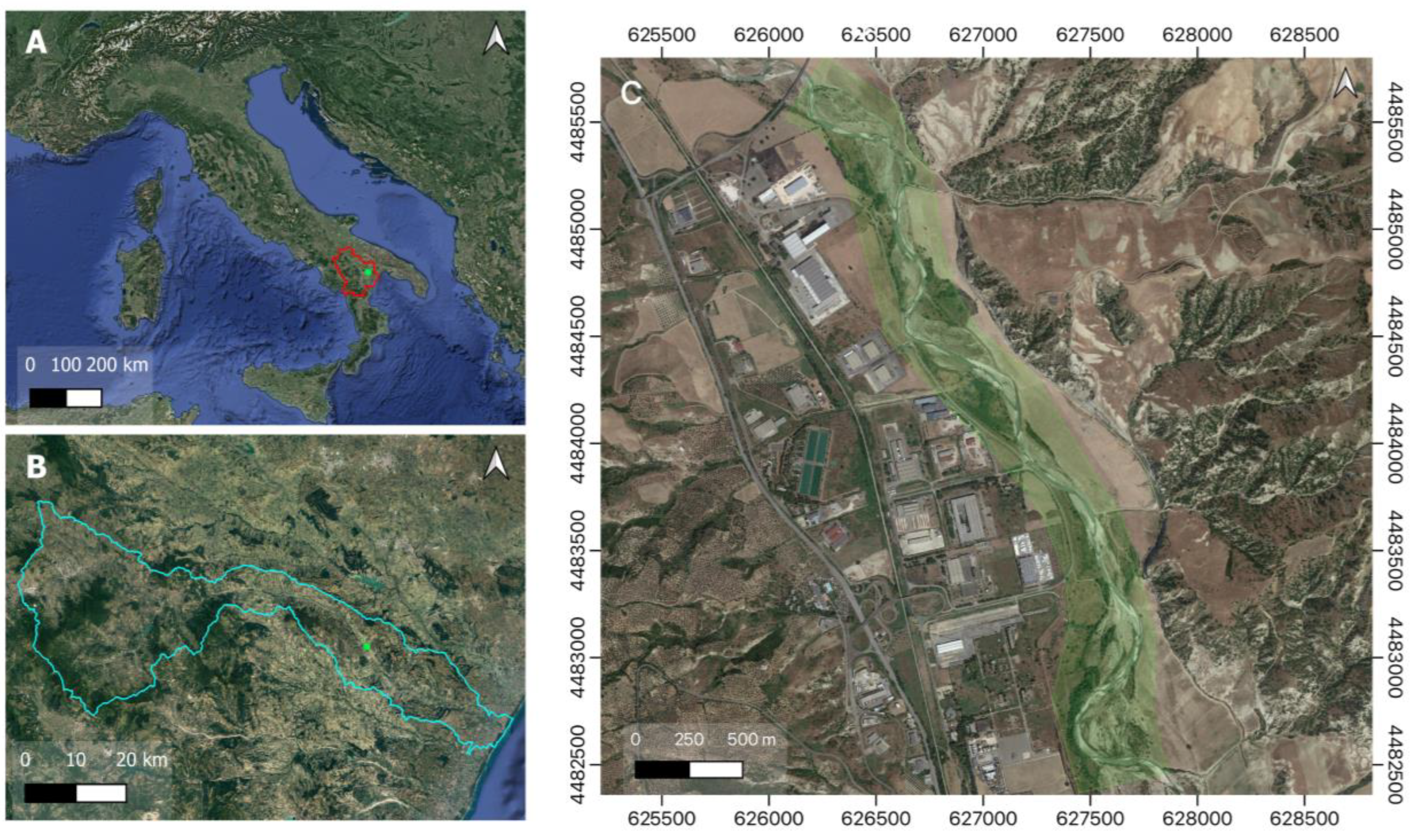
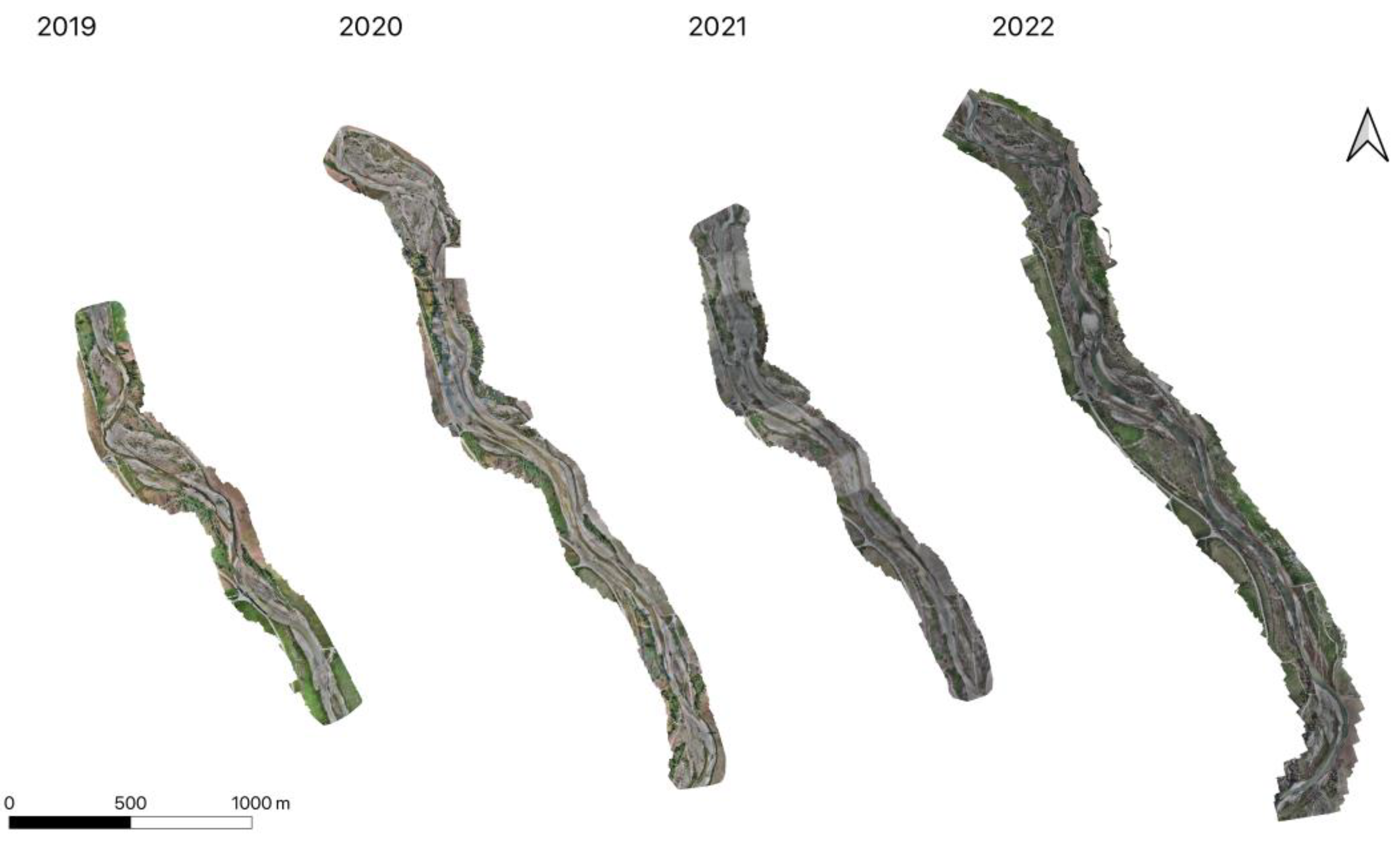
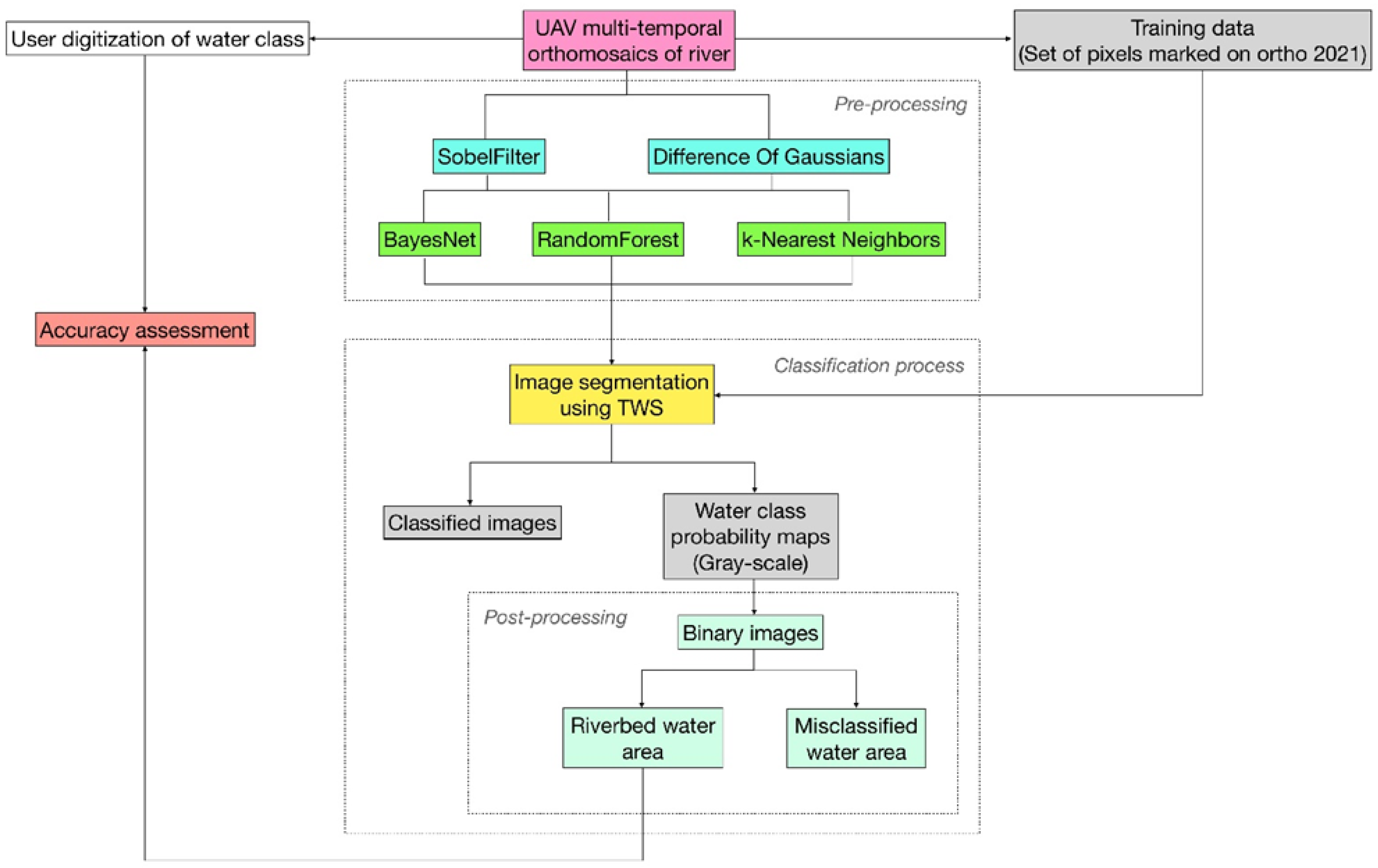
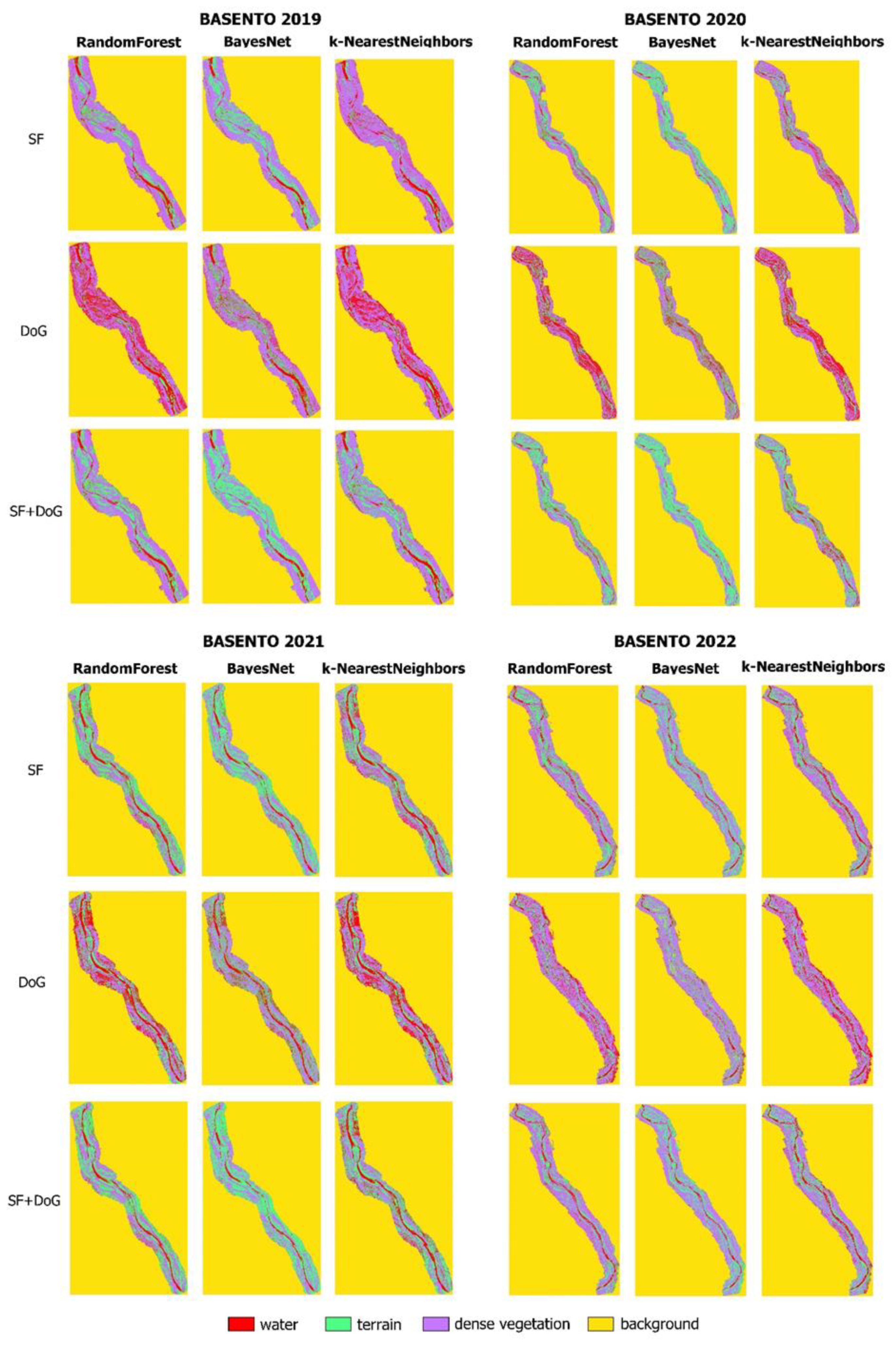
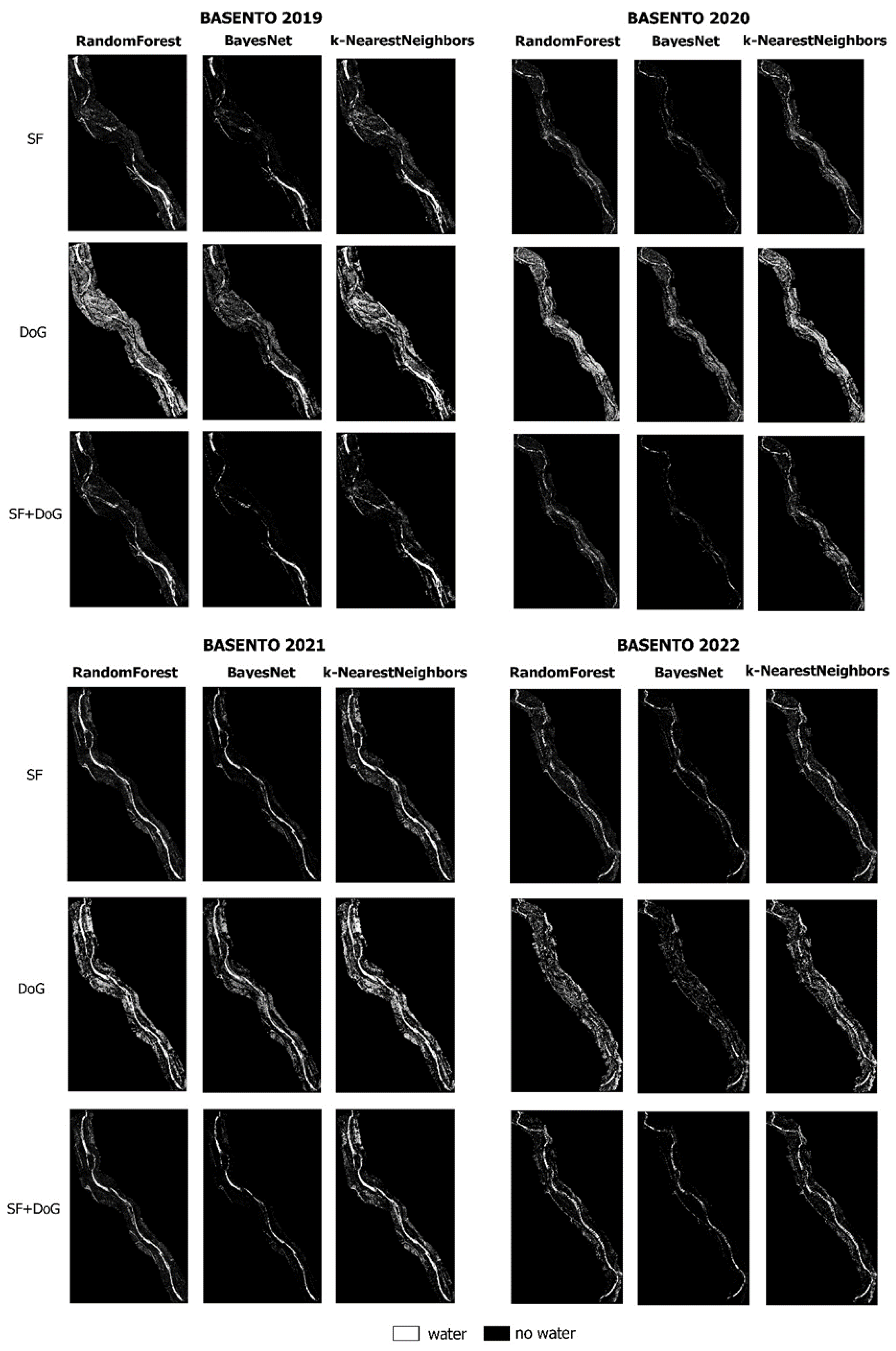
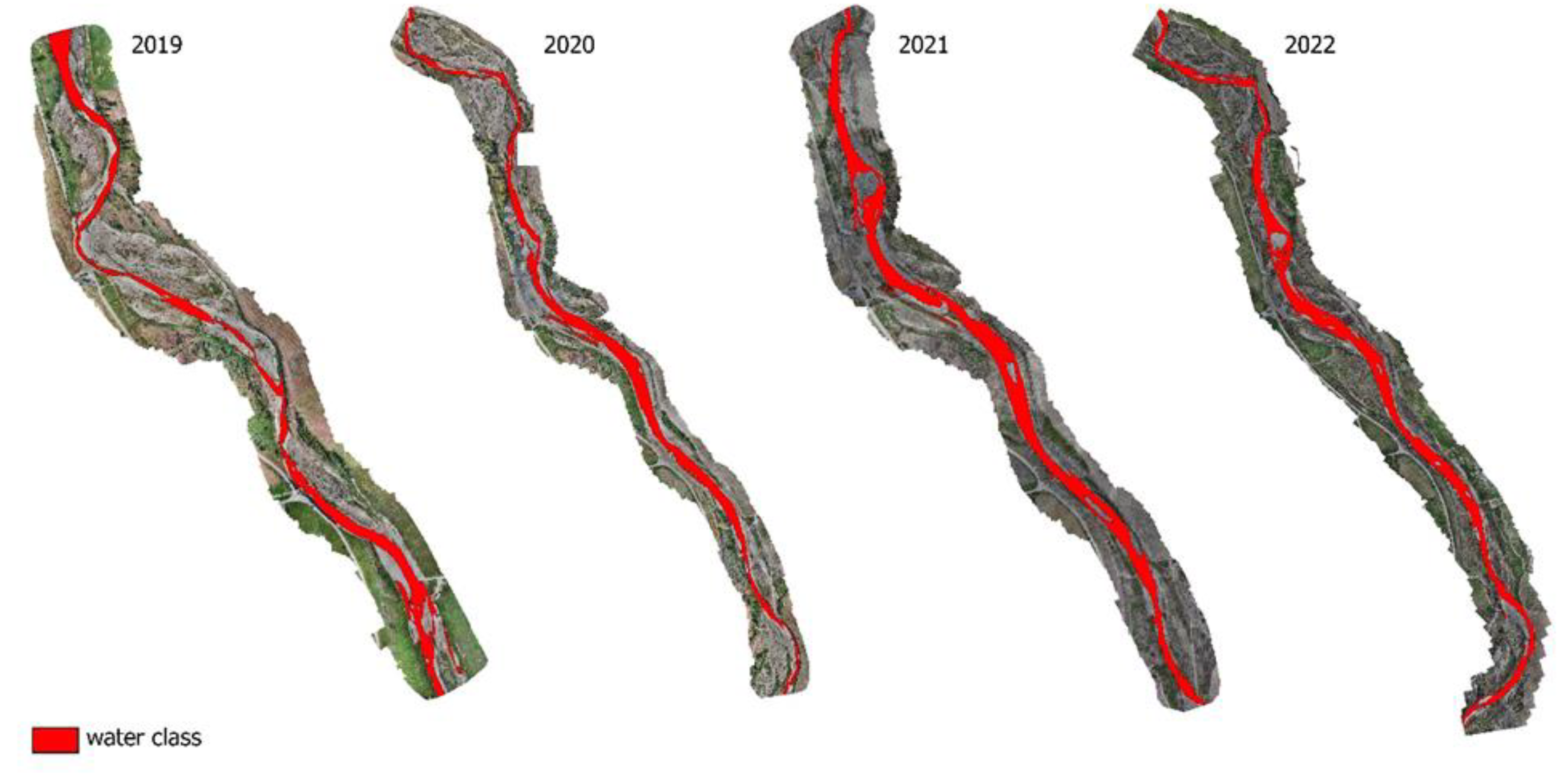
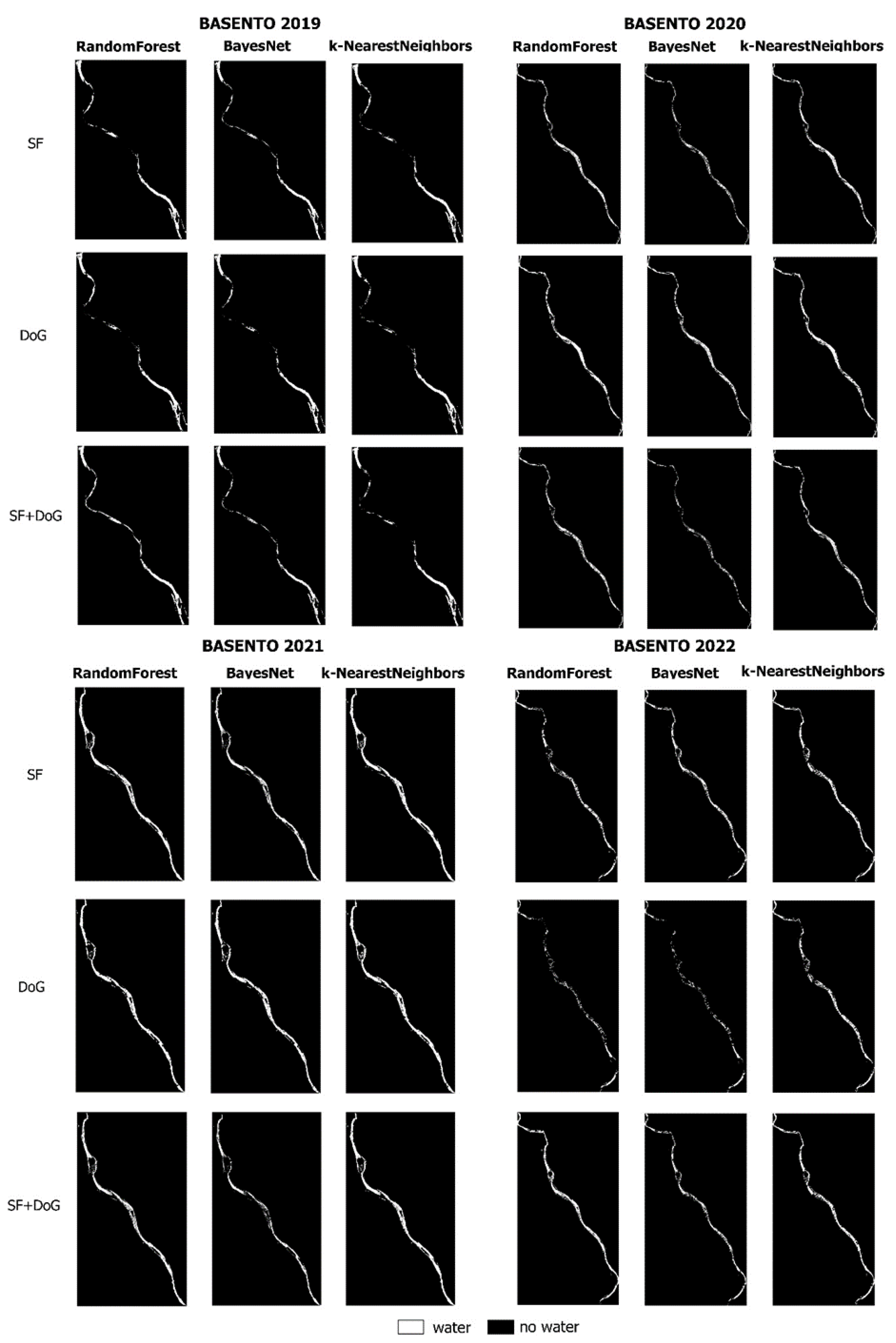
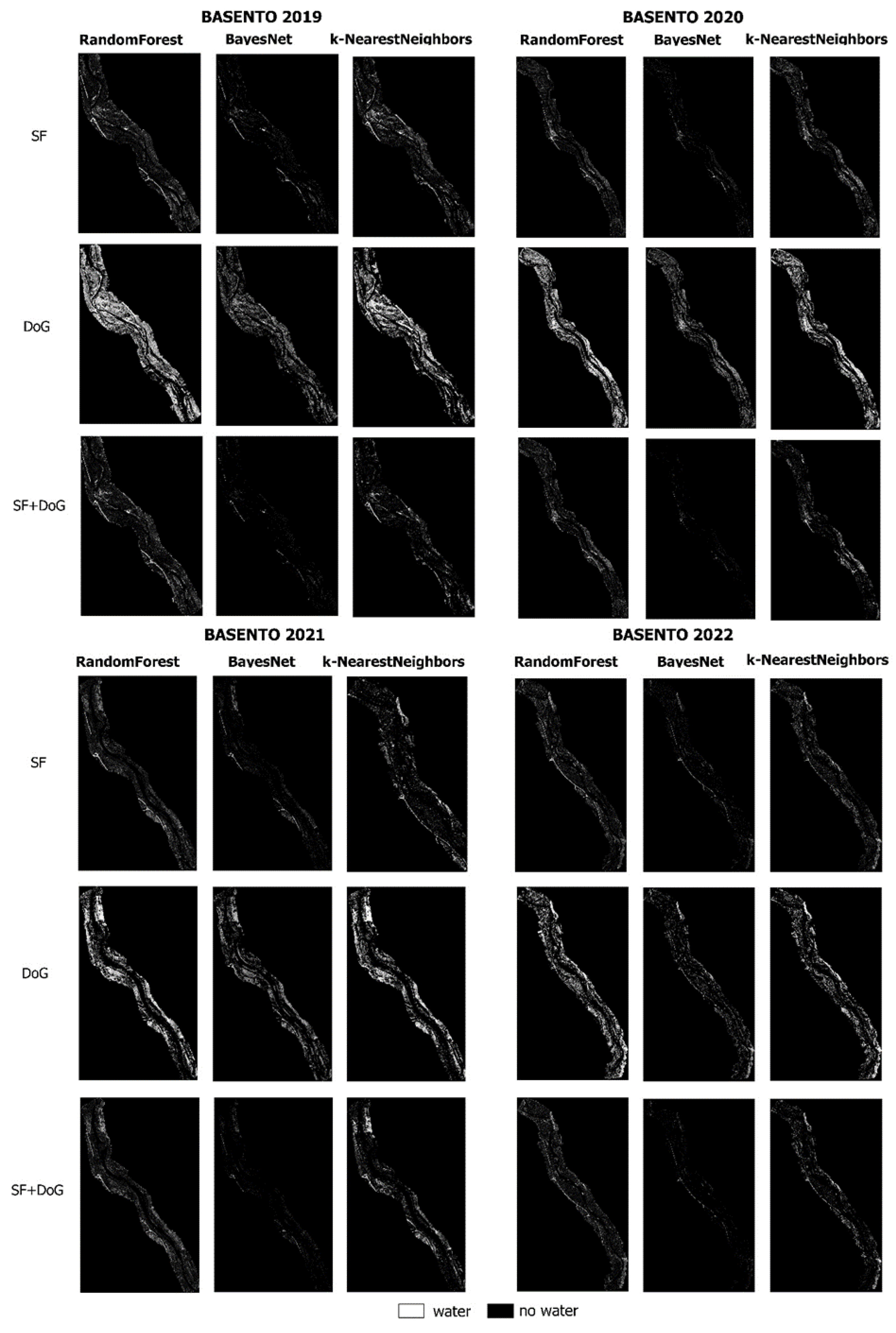
| . | RandomForest | BayesNet | k-Nearest Neighbor | ||||||
|---|---|---|---|---|---|---|---|---|---|
| Performance Measure | SF | DoG | SF + DoG | SF | DoG | SF + DoG | SF | DoG | SF + DoG |
| Accuracy (%) | 96.8085 | 97.8723 | 96.8085 | 93.6170 | 94.1489 | 95.2128 | 97.8723 | 97.8723 | 96.2766 |
| Misclassification rate (%) | 3.1915 | 2.1277 | 3.1915 | 6.3830 | 5.8511 | 4.7872 | 2.1277 | 2.1277 | 3.7234 |
| Precision (weighted avg.) | 0.9690 | 0.9790 | 0.9690 | 0.9440 | 0.9410 | 0.9570 | 0.9790 | 0.9790 | 0.9620 |
| Recall (weighted avg.) | 0.9680 | 0.9790 | 0.9680 | 0.9360 | 0.9410 | 0.9520 | 0.9790 | 0.9790 | 0.9630 |
| F-measure (weighted avg.) | 0.9680 | 0.9790 | 0.9680 | 0.9380 | 0.9400 | 0.9530 | 0.9780 | 0.9780 | 0.9620 |
| Kappa statistic | 0.9365 | 0.9572 | 0.9368 | 0.8780 | 0.8818 | 0.9070 | 0.9569 | 0.9567 | 0.9241 |
| Orthomosaic Basento 2019 | ||||||||||
|---|---|---|---|---|---|---|---|---|---|---|
| Random Forest | Bayes Net | k-Nearest Neighbors | Manual Digitization | |||||||
| SF | DoG | SF + DoG | SF | DoG | SF + DoG | SF | DoG | SF + DoG | ||
| Water area in riverbed (m2) | 35,147.46 | 35,407.47 | 37,730.88 | 31,253.84 | 33,203.96 | 29,387.79 | 34,980.80 | 34,532.09 | 32,808.49 | 47,135.98 |
| Error (%) | 25.43 | 24.88 | 19.95 | 33.69 | 29.56 | 37.65 | 25.79 | 26.74 | 30.40 | |
| Orthomosaic Basento 2020 | ||||||||||
| Random Forest | Bayes Net | k-Nearest Neighbors | Manual digitization | |||||||
| SF | DoG | SF + DoG | SF | DoG | SF + DoG | SF | DoG | SF + DoG | ||
| Water area in riverbed (m2) | 67,255.33 | 78,939.70 | 60,753.58 | 46,231.95 | 70,553.69 | 34,042.26 | 72,887.94 | 80,355.13 | 63,664.58 | 91,828.33 |
| Error (%) | 26.76 | 14.04 | 33.84 | 49.65 | 23.17 | 62.93 | 20.63 | 12.49 | 30.67 | |
| Orthomosaic Basento 2021 | ||||||||||
| Random Forest | Bayes Net | k-Nearest Neighbors | Manual digitization | |||||||
| SF | DoG | SF + DoG | SF | DoG | SF + DoG | SF | DoG | SF + DoG | ||
| Water area in riverbed (m2) | 64,300.23 | 61,433.31 | 58,294.81 | 52,521.63 | 61,071.15 | 39,037.59 | 65,805.72 | 66,903.31 | 64,274.03 | 81,073.76 |
| Error (%) | 20.69 | 24.23 | 28.10 | 35.22 | 24.67 | 51.85 | 18.83 | 17.48 | 20.72 | |
| Orthomosaic Basento 2022 | ||||||||||
| Random Forest | Bayes Net | k-Nearest Neighbors | Manual digitization | |||||||
| SF | DoG | SF + DoG | SF | DoG | SF + DoG | SF | DoG | SF + DoG | ||
| Water area in riverbed (m2) | 75,437.53 | 44,895.41 | 103,124.78 | 80,544.60 | 38,530.83 | 70,273.95 | 92,609.33 | 82,991.06 | 95,667.82 | 130,058.57 |
| Error (%) | 42.00 | 65.48 | 20.71 | 38.07 | 70.37 | 45.97 | 28.79 | 36.19 | 26.44 | |
| Orthomosaic Basento 2019 | |||||||||
|---|---|---|---|---|---|---|---|---|---|
| Random Forest | Bayes Net | k-Nearest Neighbors | |||||||
| SF | DoG | SF + DoG | SF | DoG | SF + DoG | SF | DoG | SF + DoG | |
| FP water area (m2) | 38,528.79 | 157,206.29 | 33,924.63 | 15,876.12 | 61,354.49 | 9810.49 | 56,098.31 | 113,647.05 | 34,401.36 |
| % FP water area wrt total image area | 8.37 | 34.16 | 7.37 | 3.45 | 13.33 | 2.13 | 12.19 | 24.69 | 7.47 |
| Orthomosaic Basento 2020 | |||||||||
| Random Forest | Bayes Net | k-Nearest Neighbors | |||||||
| SF | DoG | SF + DoG | SF | DoG | SF + DoG | SF | DoG | SF + DoG | |
| FP water area (m2) | 24,793.50 | 170,571.48 | 18,854.61 | 6314.43 | 79,321.43 | 6983.49 | 49,214.38 | 231,246.00 | 37,700.85 |
| % FP water area wrt total image area | 3.42 | 23.51 | 2.60 | 0.87 | 10.93 | 0.96 | 6.78 | 31.87 | 5.20 |
| Orthomosaic Basento 2021 | |||||||||
| Random Forest | Bayes Net | k-Nearest Neighbors | |||||||
| SF | DoG | SF + DoG | SF | DoG | SF + DoG | SF | DoG | SF + DoG | |
| FP water area (m2) | 22,894.14 | 75,227.14 | 13,123.71 | 3499.83 | 43,787.27 | 9965.12 | 28,516.41 | 103,959.12 | 29,340.77 |
| % FP water area wrt total image area | 4.55 | 14.95 | 2.61 | 0.70 | 8.70 | 1.98 | 5.67 | 20.66 | 5.83 |
| Orthomosaic Basento 2022 | |||||||||
| Random Forest | Bayes Net | k-Nearest Neighbors | |||||||
| SF | DoG | SF + DoG | SF | DoG | SF + DoG | SF | DoG | SF + DoG | |
| FP water area (m2) | 65,749.60 | 207,434.32 | 31,361.01 | 15,625.17 | 46,707.95 | 15,170.74 | 53,096.96 | 137,507.32 | 34,822.72 |
| % FP water area wrt total image area | 6.44 | 20.33 | 3.07 | 1.53 | 4.58 | 1.49 | 5.20 | 13.48 | 3.41 |
| Orthomosaic | Vegetation Area (ENDVI(vis))/Total Image Area |
|---|---|
| 2019 | 5.8% |
| 2020 | 1.9% |
| 2021 | 1.3% |
| 2022 | 2.8% |
Disclaimer/Publisher’s Note: The statements, opinions and data contained in all publications are solely those of the individual author(s) and contributor(s) and not of MDPI and/or the editor(s). MDPI and/or the editor(s) disclaim responsibility for any injury to people or property resulting from any ideas, methods, instructions or products referred to in the content. |
© 2023 by the authors. Licensee MDPI, Basel, Switzerland. This article is an open access article distributed under the terms and conditions of the Creative Commons Attribution (CC BY) license (https://creativecommons.org/licenses/by/4.0/).
Share and Cite
La Salandra, M.; Colacicco, R.; Dellino, P.; Capolongo, D. An Effective Approach for Automatic River Features Extraction Using High-Resolution UAV Imagery. Drones 2023, 7, 70. https://doi.org/10.3390/drones7020070
La Salandra M, Colacicco R, Dellino P, Capolongo D. An Effective Approach for Automatic River Features Extraction Using High-Resolution UAV Imagery. Drones. 2023; 7(2):70. https://doi.org/10.3390/drones7020070
Chicago/Turabian StyleLa Salandra, Marco, Rosa Colacicco, Pierfrancesco Dellino, and Domenico Capolongo. 2023. "An Effective Approach for Automatic River Features Extraction Using High-Resolution UAV Imagery" Drones 7, no. 2: 70. https://doi.org/10.3390/drones7020070
APA StyleLa Salandra, M., Colacicco, R., Dellino, P., & Capolongo, D. (2023). An Effective Approach for Automatic River Features Extraction Using High-Resolution UAV Imagery. Drones, 7(2), 70. https://doi.org/10.3390/drones7020070








